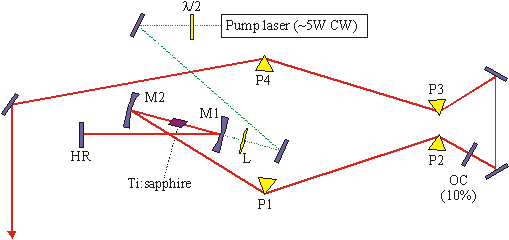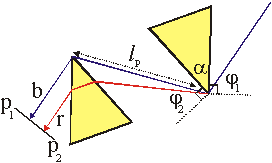
Ultra-fast pulses
Ultra-fast pulses, on the order of magnitude of femtoseconds (10-15 s), have several qualities that make them ideal for development in optical systems. First, such pulses have a particularly high peak intensity. Thus, one can achieve brighter pulses using the same amount of power. Also, ultra-fast pulses have a large spectral bandwidth. As can be seen from Fourier Transforms of light pulses, the bandwidth of short pulses can be considerable. Below is a table relating a pulse's measurement for Full Width Half Maximum (FWHM: the width of a pulse at half the maximum amplitude) and its bandwidth.
|
Gaussian Pulse duration (FWHM)/ fs |
Gaussian bandwidth (FWHM) / nm |
|
100 |
9.4 |
|
50 |
18.8 |
|
30 |
31.3 |
|
10 |
94 |
Using this to one’s advantage, it would be possible to combine aspects of WDM into the TDM system to further increase the number of channels used, since such pulses are made up of several frequencies of light. Currently, lasers have been developed with pulse periods less than 10 femtoseconds. Yet, even from pulses with a period of 250fs, it is possible to obtain over 200 channels of information from a single laser.
Ultra-fast pulses are typically generated by mode-locked lasers, of which the Ti:Sapphire laser is a commonly used option.

As shown in the diagram above, the Ti:Sapphire element is pumped by a continuous wave (non-pulsing) laser to generate the population inversion (the state at which stimulated emission is more likely to occur than excitation). If perfectly aligned, the system generates a continuous wave. However, if either M1 or M2 (curved mirrors) are shifted by as little as 0.5mm, the system enters pulse mode. The pulses are then transmitted through several prisms (P1 and P2) in order to separate the frequencies that comprise a finite pulse of light.

This separation process is known as "chirping". Finally, after the chirped pulse is amplified, the signal is recompressed using the last two prisms to make a compact wave packet. This particular setup, has been able to produce pulse lengths of a mere 10-12 femtoseconds at an 80MHz repetition rate.
The potential for growth of TDM using ultra-fast pulses is unrivaled. Between sending and receiving the signals, the only hindrance to the immense potential throughput would be the speed of the optical switching component.